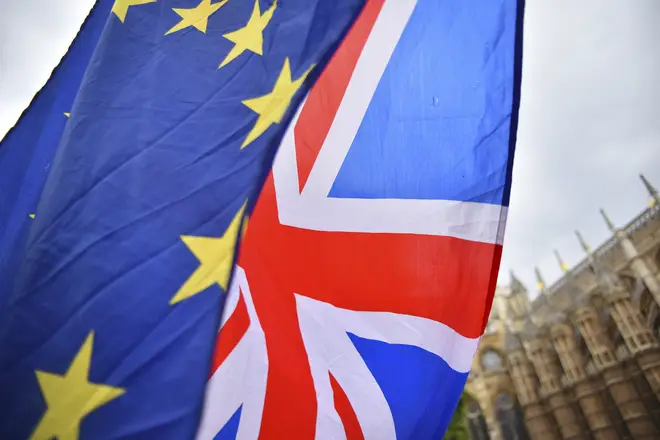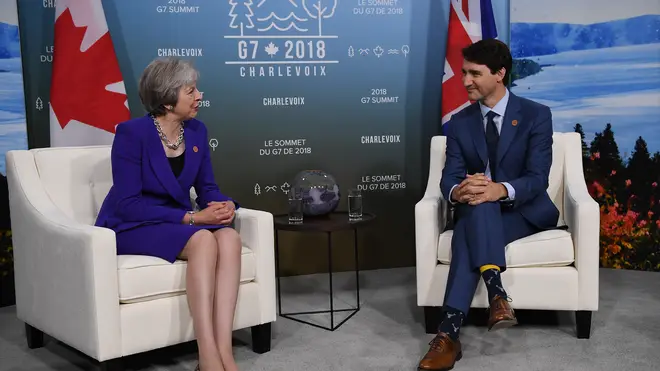
Iain Dale 10am - 1pm
10 December 2018, 12:02 | Updated: 28 October 2019, 15:53

Theresa May faces her toughest week as Prime Minister. After delaying the vote on her exit deal, all eyes are on Westminster for the next step in Brexit. But what will happen? What are the different options?
With only three months left before 29th March 2019, the "fate of Brexit" fell on one crucial vote.
MPs have expressed frustration at the deal that Theresa May negotiated with Brussels, prompting the vote to be "deferred". It is, as Donald Tusk tweeted, an "important week for the fate of Brexit".
I had a phone call with PM @theresa_may. It will be an important week for the fate of #Brexit.
— Donald Tusk (@eucopresident) December 9, 2018
- Brexit Timeline: Key Dates As The UK Prepares To Leave The European Union
The deal Theresa May negotiated with the EU was presented in a 585-page document titled her draft Withdrawal Agreement and is what MPs was expected to be voted on in Parliament on Tuesday before the Prime Minister delayed it.
Cabinet Ministers backed the plan after a five-hour-long meeting at Downing Street, but has since faced criticism from all sides.
It includes the end of freedom of movement of people, and a backstop arrangement to protect the Irish border from a hard customs border.
The withdrawal deal originated as Theresa May's Chequers proposal, which was agreed after a Cabinet summit at the Buckinghamshire residence. The deal was 'collectively agreed', but then-Brexit Secretary David Davis and then-Foreign Secretary Boris Johnson resigned their positions.
Read more about Theresa May's draft Withdrawal Agreement here.
Some MPs have called for Theresa May to renegotiate her withdrawal deal with the EU, with the hope of removing the Irish border backstop over fears it would tie the UK to a customs union for longer.
EU officials have said that the deal is 'non-renegotiable' as it crosses their red lines. The Labour Party has said that Jeremy Corbyn could renegotiate with Brussels if Theresa May's deal is rejected at the meaningful vote, but some Labour MPs have instead called for a second referendum.
Officially known as the EU-Canada Comprehensive Economic and Trade Agreement (CETA), the agreement was signed in October 2016 and took seven years to agree.
It means the removal of 99% of customs duties on exports between Canada and the EU, with a seven-year plan to remove all tariffs.
The agreement is far from comprehensive, however, with hundreds of exceptions listed. For example, it does not guarantee Canadian firms an EU financial services "passport", meaning there are still challenges to trading freely with Europe.
One of the biggest issues with a Canada-style deal is that it could create a hard border on the Island of Ireland. But in the case a backstop is created to protect the Irish border, a new customs border could be introduced between Northern Ireland and the rest of the UK.
Read more about the Canada-style deal here.

Norway is not a member of the European Union, but it is part of the European Economic Area meaning it is within the single market.
It also follows a significant number of EU rules and regulations, and contributes to the EU budget. The 'Norway model' includes freedom of movement of goods, services, people and capital - therefore Norwegians can live and work across the EU, and vice-versa.
However as a non-member, Norway has no say in making EU rules because it has no representation.
If the UK took up the same terms that Norway has, it would mean introducing a hard Irish border. So in order to avoid this, the UK would remain within a customs union with the EU - something Norway is not. This creates the 'Norway plus' model.
This arrangement has been criticised by both Leave and Remain campaigners: Brexiteers say that the model would keep the UK 'too close' to the EU, therefore not a 'true Brexit', while Remainers say there isn't any point in it because "you might as well be sitting at the table and having a vote".
Read more about the Norway Plus option here.
If the UK leaves the EU without a deal it will be bound by World Trade Organisation rules. A no-deal Brexit is also known by some Brexiteers as a 'clean Brexit'.
The WTO is a large group of member countries that agree the terms of trade between them.
The government's latest economic analysis has said that a no-deal Brexit could deliver a 9.3% hit to the UK economy in comparison to remaining in the European Union.
There have been concerns that this option would result in a hard Irish border being introduced due to different trade regulations between the UK and EU.
Read more about the WTO and a no-deal Brexit here.
If Theresa May's deal is rejected by Parliament, another option that has been suggested is a so-called 'people's vote'.
Campaigners argue that the public should decide what step the UK takes next, by voting in a new referendum.
However the question people would vote on has been contested between different groups.
Some people have suggested a vote should be between 'no-deal' and Theresa May's deal, while others believe it should be between the Prime Minister's deal and remaining in the European Union.
In order to do this, the UK may need to extend Article 50 to allow the time for a vote to take place.
If the government loses a vote of confidence in the Commons, the Labour Party has said they are ready to 'step in'.
And a spokesperson for the party has said that Jeremy Corbyn is ready to lead a minority government from Wednesday morning, if the Prime Minister's deal is rejected on Tuesday.
It is possible for either a different Tory leader or Labour could offer the DUP a deal for support, but if not it could result in a general election.
In order for any vote to happen, the UK may need to extend Article 50 to allow for time.
The European Court of Justice has ruled that the UK can unilaterally revoke Article 50, leaving the door open for the UK to remain in the European Union.
Anti-Brexit campaigners and cross-party politicians wanted the ECJ to clarify whether the notification of withdrawal could itself be withdrawn without permission from other EU member states. But after the government failed to convince the UK's Supreme Court to block the hearing, the ECJ took the case in Luxembourg at the end of November.
A statement from the Court said: "When a Member State has notified the European Council of its intention to withdraw from the European Union, as the UK has done, that Member state is free to revoke unilaterally that notification."
It added: "That possibility exists for as long as a withdrawal agreement concluded between the EU and that Member State has not entered into force or, if no such agreement has been concluded, for as the two-year period from the date of the notification of the intention to withdraw from the EU, and any possible extension, has not expired."